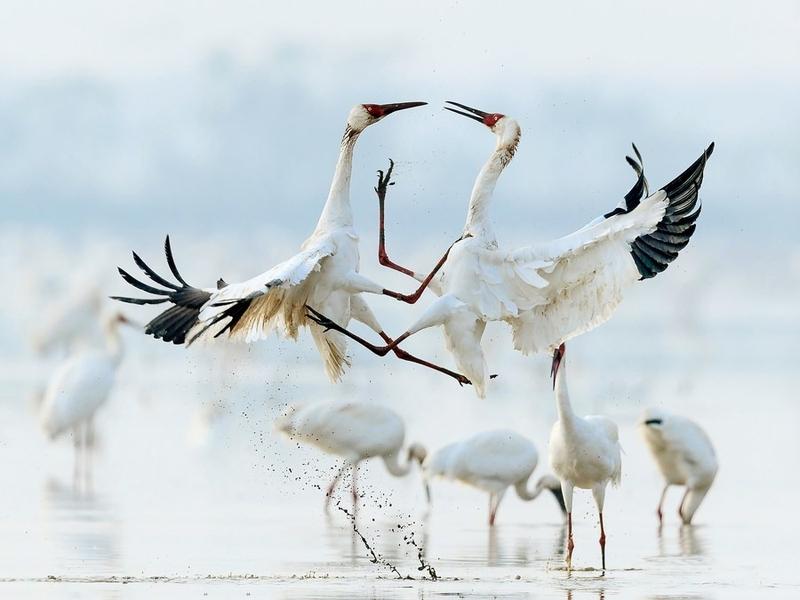 Zhou Haiyan (right), founder of the Five Stars Sanctuary in Nanchang, Jiangxi province, shows pictures of Siberian white cranes to Russian student Trofimova Iuliia. (PHOTO / XINHUA)
Zhou Haiyan (right), founder of the Five Stars Sanctuary in Nanchang, Jiangxi province, shows pictures of Siberian white cranes to Russian student Trofimova Iuliia. (PHOTO / XINHUA)
NANCHANG/MOSCOW-Trofimova Iuliia could not help humming the Russian song Cranes Flock when she saw Siberian white cranes dancing less than 20 meters away by Poyang, China's largest freshwater lake.
The Russian student studying in East China Jiaotong University, Jiangxi province, is from Siberia, where about 70 percent of such cranes start their migrating journey from the Kytalyk National Park to China.
"Like Siberian cranes, I flew from Russia to Jiangxi over 5,000 kilometers. They came to survive the winter and I came to study," says Iuliia.
Rated as critically endangered on the International Union for Conservation of Nature red list, the Siberian white crane, also known as the snow crane, only numbers around 4,000 globally, with just a single migrating route left for them on the planet.
"The Siberian white crane is alert by nature. If it has been disturbed in one place, it will never go there again," says Guo Yumin, an expert on crane protection at Beijing Forestry University.
According to Guo, Chinese researchers first discovered the Siberian white cranes in Poyang Lake in 1980. Now, about 98 percent of such cranes spend their winter in Poyang Lake.
In the Wucheng township of Jiangxi, crane images and other elements can be found everywhere, even on the telegraph poles along the main road.
Min Rui, head of Wucheng township, says the town is a popular bird-watching spot, but for decades, villagers lived on fishing, competing with migratory birds for food.
Min says the town has attracted investment worth some 1.2 billion yuan ($190 million), with birdwatching development.
Gan Huabin, 48, used to live on an islet in Poyang Lake as a fisherman. Now, he runs a restaurant in Wucheng. The local government gave Gan a discount loan of 100,000 yuan to help him find other businesses instead of fishing.
"After paying off the loan, I borrowed more to expand the restaurant. My brother who worked outside the hometown also plans to come back and participate in the tourism industry," says Gan.
 Siberian white cranes have winter fun in Poyang Lake. (PHOTO / XINHUA)
Siberian white cranes have winter fun in Poyang Lake. (PHOTO / XINHUA)
More than 1,500 people in the town are now engaged in tourism and catering businesses that are related to bird-watching, striking a balance between economic development and ecological protection.
On the southern shore of Poyang Lake, more than 1,000 Siberian cranes are foraging in the Five Stars Sanctuary, where they can find enough food even in winter.
"It's amazing. I've never seen real Siberian white cranes in my life. They don't seem to be afraid of people at all," says Iuliia.
In 2017, Zhou Haiyan, a shutterbug, together with many bird lovers, launched the Retaining the Siberian Crane initiative to build the country's first privately funded Siberian crane sanctuary that combines the functions of scientific research, education and photography.
Zhou has been dubbed by Russian media as the "Chinese mother of Siberian cranes".
Reputed as "man's closest place to Siberian cranes", the sanctuary usually attracts thousands of cranes during the peak period.
"China and Russia have been strengthening the protection mechanism for Siberian cranes," says Xu Zhiwen, head of the Jiangxi Poyang Lake National Nature Reserve Administration, adding that the administration in December signed a memorandum of understanding on strategic cooperation with Russia's Kytalyk National Park for better protecting and monitoring the birds.
According to Maria Vladimirtseva, a senior research fellow at the Russian park, the 1.8-million-hectare park is home to about 70 percent of the world's Siberian crane population.
"Migration is a very difficult and critical time in the life of crane birds, during which they face many dangers, especially for young birds," says Vladimirtseva. "During this process, the Russian and Chinese staff communicate with each other every day, informing each other of all the movements of the cranes on the flight path."
"The signing of the MoU allows us to make more efforts with Chinese colleagues. It is very important to make population statistics, and such work is relatively convenient in Poyang Lake, but impossible on the frozen ground," says Sergei Sleptsov, a research fellow at the Institute for Biological Problems of Cryolithozone of the Siberian Branch of the Russian Academy of Sciences.
"The birds know first whether the ecology is good or not," says Dai Nianhua, a researcher at the Jiangxi Academy of Sciences. "They are like 'ecological test paper' for the environment, and China and Russia have managed to expand and improve their habitats.


